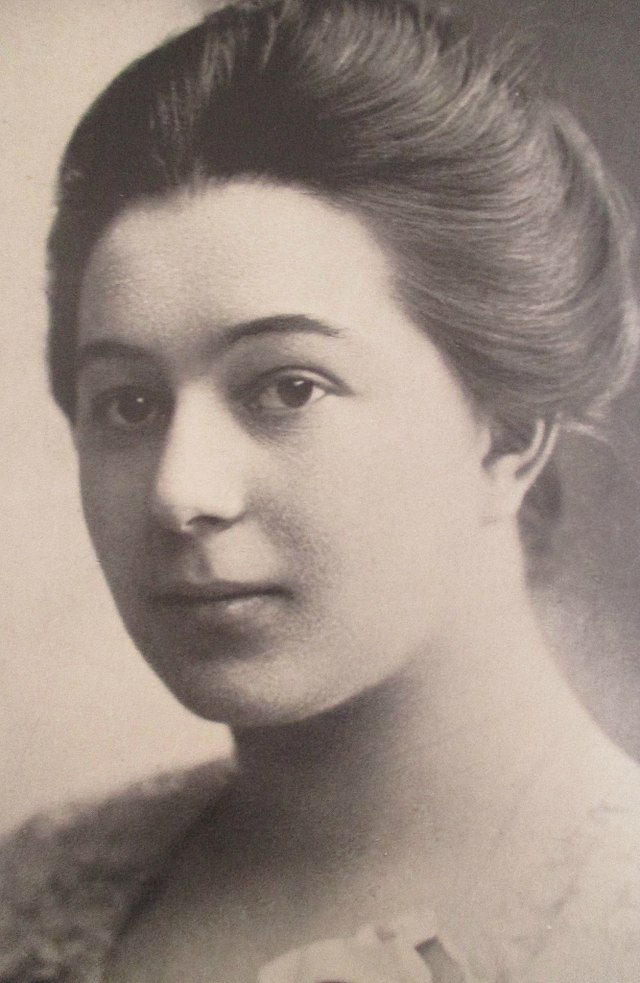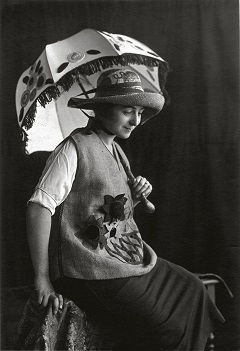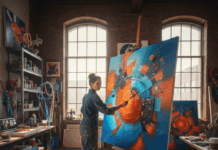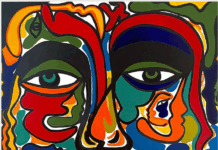Sonia Delaunay
Who is Sonia Delaunay?

French, 1885–1979
Who is she?
Sonia Delaunay was a multi-disciplinary abstract artist and key figure in the Parisian avant-garde. Alongside her husband, Robert Delaunay, she pioneered the movement Simultanism. Her exploration of the interaction between colours has created a sense of depth and movement throughout her oeuvre.
What is her background?
She was born Sonia Illinitchna Stern to a Jewish Ukrainian family. At the age of seven she went to live with her comparatively wealthy uncle Henri Terk and his wife, Anna, in St Petersburg, Russia. The Terks offered her a privileged and cultured upbringing in St Petersburg. Nevertheless, her childhood memories of Ukraine remained with her and she often referred back to the ‘pure’ colour and bright costumes of the Ukrainian peasant weddings.
How did she start her career as an abstract artist?
About 1911 I had the idea of making for my son, who had just been born, a blanket composed of bits of fabric like those I had seen in the houses of Russian peasants. When it was finished, the arrangement of the pieces of material seemed to me to evoke cubist conceptions and we then tried to apply the same process to other objects and paintings.
What does she do?
I always changed everything around me… I made my first white walls so our paintings would look better. I designed my furniture; I have done everything. I have lived my art.
Delaunay’s creativity expanded beyond painting to include many other outlets such as Casa Sonia, an interiors and fashion boutique that she set up 1918; The entire set and costume design of Tristan Tzara’s 1923 play Le Cœur à Gaz; An illustration for the cover of Vogue in 1926; Costumes for the films Le Vertige directed by Marcel L’Herbier and Le p’tit Parigot, directed by René Le Somptier; Furniture for the set of the 1929 film Parce que je t’aime; And her textiles label Tissus Delaunay, which sold her designs worldwide.
What is Orphism?
Orphism is a term originating from 1912 when French poet and art critic Guillaume Appollinaire identified the new style of Cubist painting. Appollinaire was inspired by the work of František Kupka and the Delaunays, who, although channelling the Cubist vision, prioritised colour in their work. Appollinaire felt this use of colour brought movement, light and musical qualities to the artwork and therefore referenced the legendary poet and singer of ancient Greek mythology, Orpheus, when naming the movement.
What is Simultanism?
Simultanism is the strand of Orphism practised by the Delaunays. The name comes from the work of French scientist Michel Eugène Chevreul who identified the phenomenon of ‘simultaneous contrast’, in which colours look different depending on the colours around them. For example, a grey will look lighter on a dark background than it does on a light one. The Delaunays dispensed with form and aimed to created rhythm, motion and depth through overlapping patches of vibrant hues.
Is she religious?
For a very long time I hadn’t believed in God, but I would seek out nature, and I felt the need to fulfil my desires […] Now, I would worship pagan gods; it’s the only religion I recognise. Praying to beauty — there is a great deal of selflessness in that, and a purely aesthetic element which alone ennobles life and makes it love.
Where has she exhibited her work?
As well as a major retrospective at the Kunstmuseum Bielefeld in 1958, Delaunay was the first living female artist to have a retrospective exhibition at the Louvre in 1964. She has also had her work shown at Musée d’Art Moderne in Paris, Smithsonian Cooper-Hewitt, National Design Museum, Musée des Arts Décoratifs, Musée National d’Art Moderne and Tate Modern.
What are her key artworks?
Prismes électriques (Electric Prisms), 1914, displays Delaunay’s trademark concentric circles at their best. Interpreted as an ode to modernity, Delaunay refracts the lights and bustle of Boulevard Saint Michel into almost complete abstraction. Everything disintegrates into colour except two figures, which remain discernible in the lower centre of the piece.
Nu jaune, 1908, juxtaposes the models’ warm yellow skin against lashings of cool emerald. This is one of Delaunay’s most striking uses of tone. The bright colours are frequently offset by black marks. These create a bold and heavy outline which is primitivist in its intention. The face of the model is mask like, suggesting melancholy. Delaunay makes no attempt to depict her as attractive, giving the artwork a brusque, modern feel.
What are her thoughts on colour?
Colour is the skin of the world.
Colour was the hue of number.
One who knows how to appreciate colour relationships, the influence of one colour on another, their contrasts and dissonances, is promised an infinitely diverse imagery.
What techniques did Sonia Delaunay?
The Delaunay couple used Orphism to create non-objective imagery, the significance of which was based on the intensity of the expression that they could create with color on the surface of the canvas.
What was innovative about Sonia Delaunay?
Sonia Delaunay’s innovative explorations of color and form were integral to the development of abstract art in the early 20th century. Initially inspired by quilt patterns, Delaunay eventually incorporated the stylistic concerns of Cubism, Fauvism, … Represented by internationally reputable galleries.
What materials did Delaunay use?
His reputation declined somewhat in the latter part of his career but he continued to experiment with materials such as sand, mosaics and lacquered stone to be used in his acclaimed ‘Reliefs’ series.
What medium did Sonia Delaunay use?
Painting is the practice of applying paint, pigment, color or other medium to a solid surface. The medium is commonly applied to the base with a brush, but other implements, such as knives, sponges, and airbrushes, can be used. In art, the term painting describes both the act and the result of the action.
Sonia Delaunay’s innovative explorations of color and form were integral to the development of abstract art in the early 20th century. Initially inspired by quilt patterns, Delaunay eventually incorporated the stylistic concerns of Cubism, Fauvism, and Futurism into her bright, geometric paintings and prints. She variously dubbed her style “Orphism” or “Simultaneism” and focused on the possibilities of color combinations. In 1964, Delaunay became the first living female artist to have a retrospective exhibition at the Louvre; her work would later be shown at institutions including the Musée d’Art Moderne de Paris, the Musée des Arts Décoratifs, the Centre Pompidou, Tate Modern, and Cooper Hewitt, Smithsonian Design Museum. Delaunay also worked in fashion, interior design, graphics, collage, bookmaking, and textiles—and blurred the boundaries between these disciplines and fine art.

Accomplishments
- By matching primary and secondary colors (red with green, yellow with purple, and blue with orange) to create a kind of visual vibration, Robert Dulaunay developed a new type of expressive, abstract paintings. He called this exploration “Simultaneous Contrast,” but the movement became officially known as Orphism and Sonia was one of its chief practitioners.
- The Delaunay couple used Orphism to create non-objective imagery, the significance of which was based on the intensity of the expression that they could create with color on the surface of the canvas. They placed lines of primary color beside those of secondary color, understanding that the scientific effect on the eye of such combinations would result in art that could be just as scintillating to the viewer as those depicting a standard view of reality such as a figure reclining on a couch. Their efforts produced a body of work that forced the viewer to experience their pieces visually – yet powerfully.
- Sonia Delaunay’s exploration of expressive color in the field of textile design differentiates her significantly from other members of the contemporary avant-garde. Besides designing, making, and selling garments in her own fashion boutique, she was responsible for costume design in a range of the performing arts including theatre and dance. She ended up creating a line of textiles so significant that it was picked up by one of the biggest fabric manufacturers in Europe.
Biography of Sonia Delaunay
Childhood and Education
Sonia Delaunay was born Sara Élievna Stern, the youngest of three children, to impoverished Jewish parents in Odessa, Ukraine. At five, she was sent to live with her mother’s well-off brother, Henri Terk, and his wife in St. Petersburg, Russia. Although her mother never allowed a legal adoption, Delaunay thought of them as her family and took the name Sofia Terk, using “Sonia” as a nickname. She received a good education, had access to great art collections, and traveled Europe spending summers in Finland. At sixteen, Delaunay’s art teacher noticed her talent and encouraged her uncle and aunt to send her to Germany for further art training.
Early Training
Eighteen-year-old Sonia began her studies at the Academy of Fine Arts in Karlsruhe in 1904. After two years in Germany, Delaunay moved to Paris to study at the Academie de la Palette. On December 5, 1908 she married her friend Wilhelm Uhde, an art dealer, ensuring that her family wouldn’t be able to force her to come home while also covering for Uhde’s homosexual lifestyle. Uhde gave Delaunay her first one-person show in 1908 featuring numerous portrait studies that demonstrated the early influence of Fauvists like Henri Matisse and introduced her to important art and literary figures, including, in 1909, her future husband, Robert Delaunay.
Sonia married Robert on November 15, 1910 after amicably divorcing Uhde, and their son Charles was born in January 1911. The two were to become one of the art world’s most important partnerships, co-founding Orphism, a variation of Cubist art composed of abstract forms of vibrant color.
Although Delaunay’s early work was in the field of painting, the creation of a patchwork quilt for her son instigated an entirely different direction to her work. She assembled the quilt according to a style she’d seen years earlier in Russia, laying scraps of fabric one beside the other. She was fascinated by the effects of the colors created from these strips once removed from their original context. This interesting discovery, coupled with Robert’s interest in chemist Eugène Chevreul’s theories on color, led the two to create works based on simultaneous color relationships known as Simultanism and soon enough Delaunay began to apply simultaneously contrasted colors not only to paintings, such as Bal Bullier (1912-13), but also to objects, such as cushions, boxes, and clothing.
Delaunay’s refusal to distinguish between the worlds of fine art and crafts, and her friendships with the creative people who gathered at her home on Sundays, resulted in rich a career that included exciting collaborations. Her friendship with poet Blaise Cendrars, for example, led to the creation of a series of “poem-paintings,” including La Prose du Transsibérienn et de la petite Jehanne de France (1913).
Mature Period

Delaunay traveled extensively throughout her life, each location influencing her work. While in Madrid in 1917, she began to design costumes for a production of Cléopâtre. This was just the first of what would become a number of ballet and theatrical performances for which she would provide designs. The following year she opened a design and fashion shop known as Casa Sonia. Never favoring one artistic pursuit over another, she described these diverse endeavors as, “noble work, as much as a still-life or a self-portrait.”
Between the years 1918 and 1935, Delaunay painted very little, devoting herself to parenting and trying to make a living in order to support Robert’s artistic career. She opened a fashion shop featuring her designs in Paris in 1921 which quickly attracted glamorous customers such as Hollywood actress Gloria Swanson. Delaunay’s fabric designs became so popular that she eventually started her own company with Jacques Herm in 1924 and began a relationship with the Holland-based department store Metz & Co. the following year that would last more than three decades. A growing interest in the Dada art movement led to a fashion collaboration with poet Tristan Tzara, creating “dress-poems” with designs featuring color combinations inspired by his words.
Delaunay returned to painting in 1937 when she and Robert were asked to decorate two buildings for the Paris Exposition Internationale des Arts et Techniques dans la Vie Moderne. The murals she created for this commission were well received. After Robert’s death in 1941 things became very difficult and Delaunay survived by selling both her own designs and Robert’s paintings. Being of Jewish heritage she was forced to move frequently during the war, worried that she would be arrested. There was an occasion, in Cannes, when she was questioned regarding her middle name, “Stern.” Apparently she stood her ground and, refusing to show fear, succeeded in boarding her train and escaping capture. Delaunay was acutely aware of the war, frequently hearing gunfire and watching German troop activity from as close as just outside her hotel windows.
Later Period
At the end of the war, in 1944, Delaunay returned to Paris, intent on assuring that Robert’s artistic legacy received proper recognition. When she was confident that this goal had been met she finally began to focus on her own art, concentrating primarily on painting with a series of gouaches in the 1950s called Rhythme coloré. The series explored the power of color, and the inherent rhythm in their combination on the canvas.
In 1964 Delaunay met author and poet Jacques Damase who would eventually become her partner, nurturing her late career by arranging numerous gallery exhibitions as well as the 1967 retrospective of almost 200 works at France’s Musée Nationale d’Art Moderne.
Near the end of her life, Delaunay’s work achieved both acknowledgement in her own country as well as global attention. As a measure of goodwill, French President Pompidou even gifted U.S. President Richard Nixon her painting Rhythme-couleur No. 1633 (1969).
In 1978, a year before she passed away, she helped design costumes for a performance of the play Six Characters in Search of an Author and finally published her autobiography. Having made an impact on both the art and fashion worlds, it was fitting that she chose to be buried in a dress that Hubert de Givenchy had designed for her to wear while attending a reception for England’s Queen Elizabeth.
The Legacy of Sonia Delaunay
Orphism inspired artists such as Paul Klee to explore the effect of non-objective colored shapes. Later, proponents of the Op art movement, such as Bridget Riley, used color and shape to create optically-charged movement and vibration in their works that have connections to Delaunay’s explorations. Kinetic movement artists, such as Yaacov Agam and Alexander Calder, continued this investigation in the third dimension in their sculptural constructions as well. Delaunay’s textile designs extended the range of her influence into fashion, home decor and the theater. Her ability to introduce art into regular life by creating and wearing clothing, and living in spaces that were of her own design, can be seen as an early form of performance art, inspiring contemporary artists such as Marina Abramovic.
Souce: https://www.theartstory.org/artist/delaunay-sonia/
More about Sonia Delaunay https://en.wikipedia.org/wiki/Sonia_Delaunay







